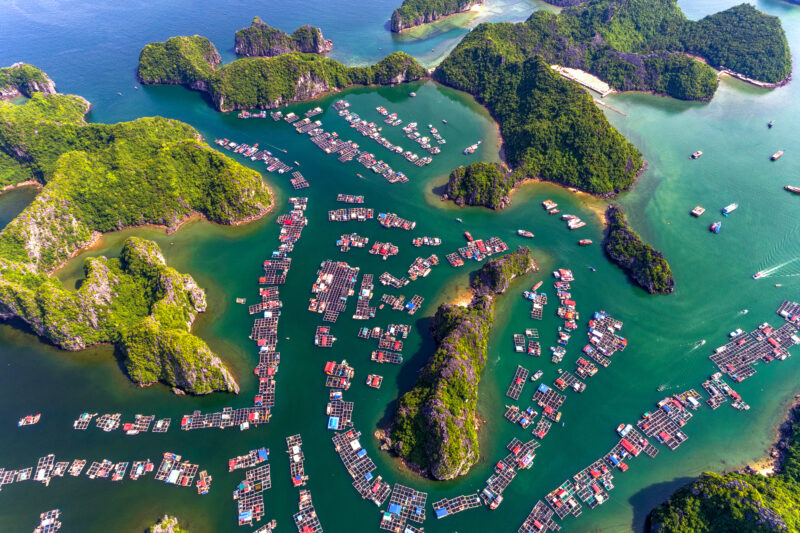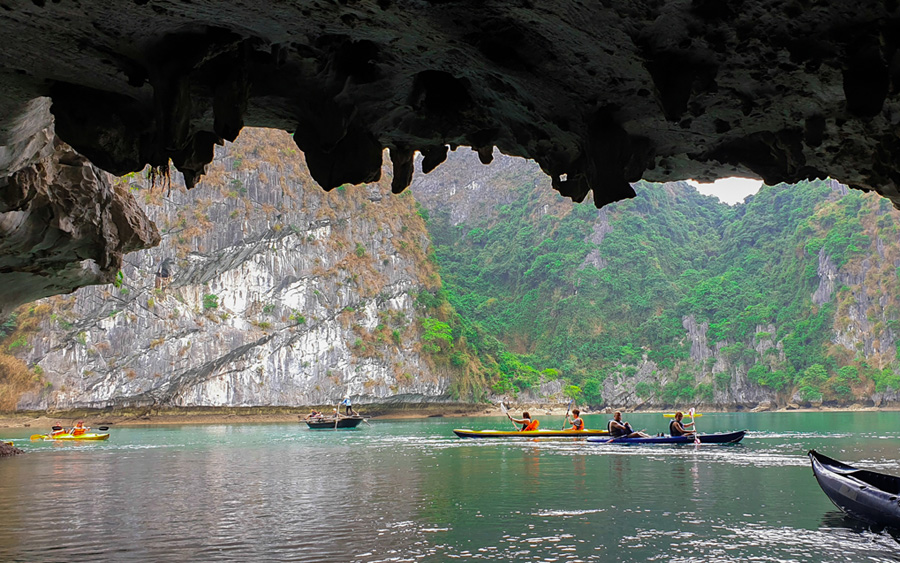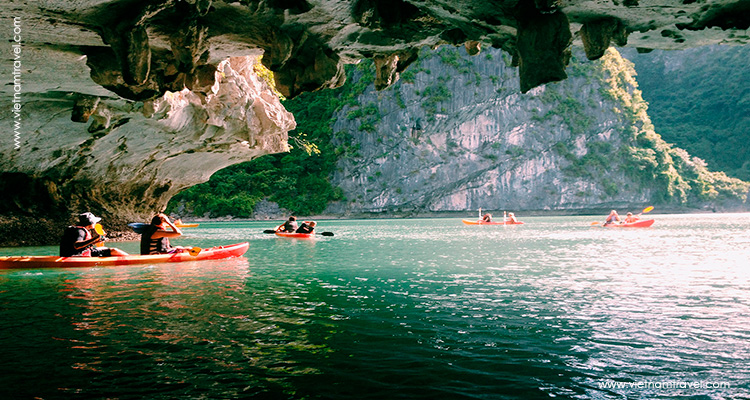I find myself admiring the view in front of me while leaning over the rails of the Dora Cruise boat. Row after row of magical creatures that resemble giants and were ripped right out of a fairytale are shimmering through the haze.

Slowly, it’s clear, these are the towering karsts of Lan Ha Bay coming into focus, Mother Nature adding brush strokes to her canvas. Plants cascade down from the rock face, greens mixing with the greys and silvers of the limestone beneath, while butterflies flap lazily among little white flowers just visible through the foliage. Passengers and crew are dumbstruck, but, as my gaze roves around the rest of the bay, I notice something else: there’s not another ship in sight. In comparison with the booming tourist trade in neighbouring Ha Long Bay, where dozens of ships ply the waters daily and where travellers are surrounded by so many boats that the megaliths somehow lose their magic, Lan Ha Bay is the area’s quieter alternative. Very few cruise companies have permission to sail here, so for most of the journey, I’m sharing the water with a handful of fishing boats, dwarfed in size as they sail past the stone giants. “Families live on board for many weeks at a time,” the ship’s guide, Dien, reveals, waving to a rickety boat that bobs past, crab baskets hanging precariously from the back. “They won’t return to their village until all their nets are full.” A family of three returns his greeting, a little girl no older than six grinning up at us, her eyes twinkling mischievously.

Unlike Ha Long Bay, much of which is protected as a UNESCO-designated site and where fishing is strictly forbidden, Lan Ha Bay is home to hundreds of people, most of whom live in floating villages and depend on the sea for survival. “The goddess of the ocean is the most important deity to this community,” Dien tells me. “They depend on her for safe passage, for a good catch and to protect their families. Every boat you see will have a tiny shrine inside, dedicated solely to her.” The fishing boat in front of us — painted in red, blue and green, with the Vietnam flag fluttering in the breeze — slowly disappears behind another limestone mountain. Life must be hard on board the tiny vessel, I think, constantly at the mercy of the elements, waiting for the sea goddess to grant a catch so bountiful one can finally return home.

Each island in the biodiverse bay is covered in dense forest, ripe for exploration.
The family of fishermen come to mind again as we sit down to a lunch of fluffy rice, papaya salad and grouper so fresh it must have been caught that morning. Each course is served by waiters in dinner jackets who are all so polite that I nearly find myself bowing back to them. After eating far more than is comfortable, Dien drags me down to the bottom deck to take kayaks out into the bay. On the water, the perspective shifts and soon I’m among the karsts themselves, so close I can run my fingers across the rock. There are a thousand colours in the stone, including yellows and greens and whites and silvers. When the sun appears from behind a cloud, they shine the colour of molten steel. “You can’t believe that nature can make this, eh?” says Dien, who seems just as enthralled despite having sailed here countless times. “It’s like big people are playing games.” And indeed, deep, vertical grooves in the rock face do look like giants have drawn their fingers down fresh clay.

“There are 366 islands in this area — just imagine them bursting from the ground around 20 million years ago.” We paddle beneath stone arches and past empty bays, pausing to watch a woman collect clams with a bucket and chisel, before heaving our kayaks onto a deserted beach. “Do you see the man in the top hat?” asks Dien, pointing at a karst to our left, “and what about that one, what shape is that?” I look at the perfectly phallus-shaped rock and pause awkwardly, wondering if that’s really what he’s getting at. “A thumb, of course!” Back on board and wrapped in a fluffy dressing gown, I head to my room. The Dora boat is one of the newest ships in the bay, and everything sparkles. The super-king-size bed is a paradise of plump pillows and silky sheets, while my private deck stretches right to the bow of the boat, complete with sun loungers and a swinging sofa big enough for four.
![]()
The bathroom is better still — it’s enormous with floor-to-ceiling windows.Outside, the sun is setting, staining the sky a dusky pink and casting long shadows across the water. An eagle swoops past my window, skimming the waves for eels, and another lone fishing boat putters slowly past. As usual, the bay is almost completely empty of ships, and in the soupy light, the stone mountains emit a soft, golden glow — as magical as ever.

Watch fishermen navigate their daily haul from the deck of a Lan Ha cruise.
Source: https://www.nationalgeographic.com








